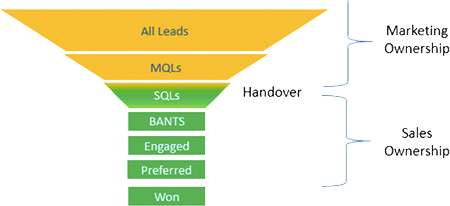Get a quick quote with our pricing calculator
Without a sales process, you are doomed!
If you are lucky enough to run a business whose products just sell themselves – you can stop reading right now and do something more productive.
If however, like me – and the vast majority of the business community – you need sales people to help sell your products and services, then the importance of understanding and defining your sales process cannot be underestimated.
Many business leaders are naturally great sales people. They know their products inside out, understand the value it brings to clients; they know the competitive market and how to deal with customer objections. Put the CEO in front of a prospect and the deal gets closed.
Replicating business success
 However, it’s difficult to scale a business if every sale requires the CEO. So you invest in sales people to run deals and recruit a marketing team to generate some leads and look to replicate the success.
However, it’s difficult to scale a business if every sale requires the CEO. So you invest in sales people to run deals and recruit a marketing team to generate some leads and look to replicate the success.
This is often when organisations will invest in CRM and come to vendors like Workbooks. Business leaders are looking to grow their revenues and want better visibility of sales and market activities.
I’ve met many customers at this stage of growth and I will often ask them: “What is your sales process, do you have a set of stages or steps you go through consistently to complete a sale?”
Some customers have real clarity on their sales process. But more often than not it is ambiguous, with different people having different views or answers like: “Well we go and visit a client, we send a quote, then they place an order. So, our sales stages should be: 1 – Customer Visit; 2 – Quote Sent; 3 – Awaiting Order; 4 – Closed Won.” However, in my experience, these aren’t stages in a sales process, but more activities that can happen during a sales engagement.
Finding clarity in the sales process
 For example, some prospects will ask for a quotation right at the beginning of a sales processes, because they are trying to get a sense of cost to help them define their budget.
For example, some prospects will ask for a quotation right at the beginning of a sales processes, because they are trying to get a sense of cost to help them define their budget.
They may also ask for a quotation right at the end of the process because they want to negotiate price and understand the details of the items they will be ordering. So, in my opinion, sending a quotation or visit a customer for that matter are not stages in the process.
This lack of clarity of the sales process can cause real confusion with sales and marketing teams. It makes it difficult to:
- Forecast your pipeline, because there is no clear definition of stages
- Understand why deals get stuck in a specific stage
- Coach sales people on how to improve their execution if there are no guidelines
- Understand why you lose deals
- Effectively track leads from marketing and measure ROI
- Identify key deals
Successful selling is a combination of art and science; as such no two sales engagements are ever the same. However, the most successful sales people understand that a good quality sales process can provide a framework for managing opportunities and can significantly improve conversation rates.
Identifying the true process
From our experience, often the first part of a CRM deployment is coaching customers to define their sales process. It doesn’t need to be too complex, but it should cover the entire journey from marketing to sales.
Many organisations formalise their processes as part of a ‘funnel’ or ‘demand waterfall’. Sirius Decision, for example, have an interesting and detailed waterfall model for B2B organisations that is worth looking into.
Internally at Workbooks, our funnel looks like this:

The top of the funnel is owned by Marketing. All leads generated by the business are tracked; we further refine our approach by scoring leads, based on company / contact demographics and activities, in order to define which leads are Marketing Qualified Leads (MQL).
These are leads which are the right type for the business. For example, in our case we focus on mid-size organisations, therefore our minimum criteria for an MQL is the organisation must employee 20 people or more.
This allows sales to hold marketing to account for the ‘right kind’ of leads. The MQLs are passed to an internal business development team. If they accept them – they are called Sales Accepted or SQLs. These are the leads we are going to invest time, further exploring and qualifying.
Getting leads to the BANTS stage
 The business development team are responsible for moving the opportunity through the funnel to the BANTS stage. BANTS is an acronym and it stands for:
The business development team are responsible for moving the opportunity through the funnel to the BANTS stage. BANTS is an acronym and it stands for:
- Budget: Does the prospect have the budget?
- Authority: Who will be involved in making the buying decision?
- Need: What are the customers’ problems and can we solve them?
- Timeframe: Is the prospect going to buy in the next 6-9 months
- Size: What is the size of the opportunity in pounds/dollars
Once an opportunity has been BANTS qualified it is passed to our more experienced field sales team who are then responsible for running the sales process through to closure. We have 5 different stages within our sales cycle.
This clear definition of the funnel enables us to closely align marketing and sales and provides a common language to manage and review opportunities. It allows salespeople to clearly understand where they (and their prospects) are in the sales cycle and what actions they need to take at each stage. It allows us to train the sales team in a consistent way, ensuring each sales person follows our best practice guidelines and doesn’t drop the ball.
We can report consistently across the business on performance, sales velocity, conversion from stage to stage, individual sales rep performance enabling us to identify potential issues, manage our pipeline and forecast accurately.
Aligning Marketing content to the Sales process
From a marketing perspective, the marketing team can provide content and messaging adapted to each stage in the sales cycle. For example, content explaining how to build a business case for CRM is important in the early stages when the prospect hasn’t yet defined a budget, but in later stages prospects will be more interested in case studies and references.
All of these processes are underpinned by our CRM platform. Marketing and sales working in unison enable us to drive a more efficient and effective sales cycle, offer a better customer experience, be more relevant and ultimately drive greater revenue.
Your business will sell more – if you can define your sales process!